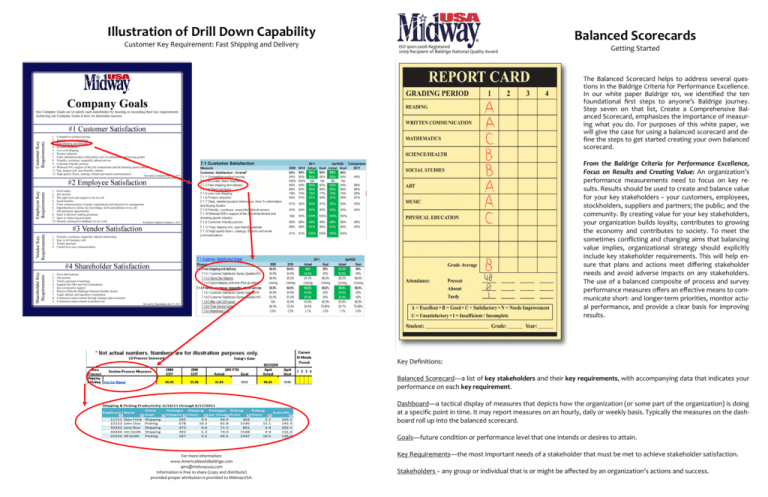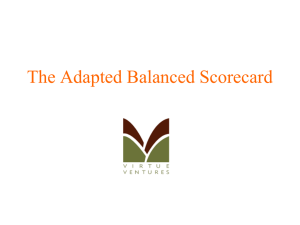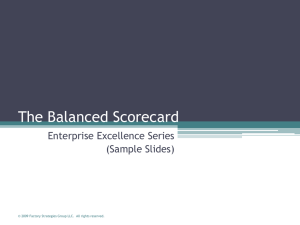Balanced Scorecards Illustration of Drill Down Capability
advertisement

Illustration of Drill Down Capability Customer Key Requirement: Fast Shipping and Delivery Balanced Scorecards ISO 9001:2008 Registered 2009 Recipient of Baldrige National Quality Award Getting Started The Balanced Scorecard helps to address several questions in the Baldrige Criteria for Performance Excellence. In our white paper Baldrige 101, we identified the ten foundational first steps to anyone’s Baldrige journey. Step seven on that list, Create a Comprehensive Balanced Scorecard, emphasizes the importance of measuring what you do. For purposes of this white paper, we will give the case for using a balanced scorecard and define the steps to get started creating your own balanced scorecard. From the Baldrige Criteria for Performance Excellence, Focus on Results and Creating Value: An organization’s performance measurements need to focus on key results. Results should be used to create and balance value for your key stakeholders – your customers, employees, stockholders, suppliers and partners; the public; and the community. By creating value for your key stakeholders, your organization builds loyalty, contributes to growing the economy and contributes to society. To meet the sometimes conflicting and changing aims that balancing value implies, organizational strategy should explicitly include key stakeholder requirements. This will help ensure that plans and actions meet differing stakeholder needs and avoid adverse impacts on any stakeholders. The use of a balanced composite of process and survey performance measures offers an effective means to communicate short- and longer-term priorities, monitor actual performance, and provide a clear basis for improving results. Key Definitions: Balanced Scorecard—a list of key stakeholders and their key requirements, with accompanying data that indicates your performance on each key requirement. Shipping & Picking Productivity: 6/10/11 through 6/17/2011 Employee ID Name 11111 22222 33333 44444 55555 Stan Frink John Doe Jane Doe Jim Smith Jill Smith Home Dept Shipping Picking Shipping Shipping Picking Packages Shipped 202 678 472 392 187 Shipping Hours 4.5 10.3 6.6 5.3 4.2 Packages per Hour 44.9 65.8 71.5 74.0 44.5 Picking Scans Picking Hours 364 2196 891 1548 1447 For more information: www.AmericaNeedsBaldrige.com qms@midwayusa.com Information is free to share (copy and distribute) provided proper attribution is provided to MidwayUSA. 2.2 15.1 4.4 9.9 10.6 Scans/Hr 165.5 145.4 202.5 156.4 136.5 Dashboard—a tactical display of measures that depicts how the organization (or some part of the organization) is doing at a specific point in time. It may report measures on an hourly, daily or weekly basis. Typically the measures on the dashboard roll up into the balanced scorecard. Goals—future condition or performance level that one intends or desires to attain. Key Requirements—the most important needs of a stakeholder that must be met to achieve stakeholder satisfaction. Stakeholders – any group or individual that is or might be affected by an organization’s actions and success. Balanced Scorecards Getting Started The Steps for Getting Started 9001:2008 Registered 2009 Recipient of Baldrige National Quality Award The Case for the Balanced Scorecard Comprehensive Balanced Scorecard—A balanced scorecard is simply a list of key stakeholders and their key requirements, with accompanying data that indicates your performance on each key requirement. Data from your internal processes, as well as survey data, can be used. The balanced scorecard should also display your goals; i.e., 91% Student Satisfaction, 94% Patient Satisfaction, etc. The balanced scorecard puts all of your important results on one page. Another benefit of the balanced scorecard is that at any level of the organization it is the grade card of the performance at that level. Whether at the Company, Department or Area level, you can see shortcomings in performance that can be addressed. Depending on the performance issue, you can determine the corrective action that may be required and then feed it back into process improvement or possibly even the strategic planning process. 1. Stakeholder Key Requirements—Stakeholders are any group or individual that is or might be affected by an organization’s actions and success. Key Requirements are the most important needs of a stakeholder that must be met to achieve stakeholder satisfaction. Each of your key stakeholders will have their own set of requirements. For example, employees want good compensation and benefits, advancement opportunities and a good working environment. Customers require competitive pricing and friendly service. Patients want friendly, knowledgeable doctors and nurses and clear communication. Students want engaging teachers and accessible technology. 4. Identify comparative data—Your organization needs to know where it stands relative to competitors and to best practices. Selection of comparative data requires that you set criteria for seeking appropriate sources for comparisons—from within and outside your organization’s industry and markets. Examples of comparative data include industry data collected by a third party (frequently industry averages), data on competitors’ performance, and comparisons with similar organizations that are in the same geographic area or that provide similar products and services in other geographic areas. Balance—Without proper balance you may not be meeting the requirements of your key stakeholders and may be focusing on the wrong areas to improve. An example would be the need to balance the Customer Key Requirement of competitive pricing with the Shareholder Key Requirement of profits and growth. If you allow one to trump the other, you may lose Customers because of prices that aren’t competitive or you may dissatisfy shareholders with lower profits. The balanced scorecard helps ensure that each stakeholder gets what they need without sacrificing the needs of the other stakeholders. Roll up and drill down capability of information—One of the things we learned early on is that different levels and measures are needed at different levels in the organization. Your senior leaders will be looking at broader, “rolled up” measures. The more you drill down into the organization the more granular the measures will be. The senior leaders need to be able to get to the detail only if a top level measure isn’t meeting the goal. Identify your Stakeholders—The term “stakeholders” refers to all groups that are or might be affected by an organization’s actions and success. Examples of key stakeholders might include customers, employees, patients, students, suppliers and taxpayers. 2. Identify Stakeholder Key Requirements—Key requirements are the most important needs of a stakeholder that must be met to achieve stakeholder satisfaction. Ask your stakeholders what is important to them. 3. Identify Process and Survey Measures—Measures are needed to better understand how we are performing toward meeting stakeholder key requirements. Ideally, both a process (leading indicator) and survey (lagging indicator) measure will be identified for each stakeholder key requirement. Typically a process measure will tell you how a process that is important to providing a stakeholder requirement is performing, and a survey measure will tell you the stakeholder’s perception of their requirement being met. Both are integral to understanding your ability to meet your organizational goals. 5. Set Goals—The term goals refers to the future condition or performance level that you intend or desire to attain. They can be both short– and longer-term. Goals are ends that guide actions. Goals can serve many purposes , including: clarifying strategic objectives and action plans to indicate how you will measure success; fostering teamwork by focusing on a common end; encouraging “out-of-the-box” thinking (innovation) to achieve a stretch goal; and providing a basis for measuring and accelerating progress. 6. Create a plan to review and use the scorecard—Analysis supports a variety of purposes including comparing your performance with competitors’ or with “best-practices” benchmarks. Performance analysis includes examining performance trends; organizational, industry and technology projections; and comparisons, causeeffect relationships and correlations. Through the analysis of data from your tracking processes, your measures or indicators themselves may be evaluated and changed to better support your goals. Scorecard Results Review—this is an overview of a sample Scorecard Results Review and illustrates the roll-up and drill down of scorecards and measures. Monthly Company Goal Performance, Company Scorecard and Customer Satisfaction and Detail are reviewed by senior leaders at monthly results review meetings – Think of it as an executive summary. Monthly Department Scorecard reviewed by the president and department head during monthly presidential department results review Area Process Measures – on intranet and reviewed in monthly department leadership teams meetings Employee Performance – reviewed throughout the day by supervisors and employees Company Daily Dashboard includes measures from multiple Key Processes which are displayed for the previous 30 days








